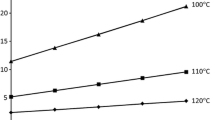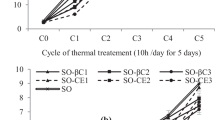Abstract
This study aimed to evaluate the oils of soybean (S), papaya (Pa) and melon (Me) seeds and compounds oils SPa (80:20 w/w); SMe (80:20 w/w); and SPaMe (60:20:20 w/w/w) subjected to thermoxidation. Compound oils showed lower percentages of free fatty acids in relation to others, after 20 h. With the heating process, there was an increase in the quantity of saturated and monounsaturated acids. The quantity of carotenoids decreased, except in papaya seed oil that presented significant amount of carotenoids in 20 h. In relation the tocopherols, highlighted the presence of γ-tocopherol, except in the papaya oil. In 20 h, SMe and SPa still showed high amounts of tocopherols, with 76 and 85% of retention, respectively. With the thermoxidation, the amounts of phytosterols decreased. A great potential can be verified for the use of papaya and melon seed oils, in order to increase the oxidative stability of the soybean oil.

Similar content being viewed by others
References
Silva AC, Jorge, N. Bioactive compounds of the lipid fractions of agro-industrial waste. Food Res. Int. 66:493–500 (2014)
Porte A, Silva EF, Almeida VDS, Silva TX, Porte LHM. Propriedades funcionais tecnológicas das farinhas de sementes de mamão (Carica papaya) e de abóboras (Cucurbita sp). Rev. Bras. Prod. Agro. 13:91–96 (2011)
Steenson DF, Min DB. Effects of β-carotene and lycopene thermal degradation products on the oxidative stability of soybean oil. J. Am. Oil Chem. Soc. 77:1153–1160 (2000)
Karpinska M, Borowski J, Danowska-Oziewicz M. The use of natural antioxidants in ready-to-serve-food. Food Chem. 72:5–9 (2001)
O’Brien RD. Fats and oils: formulating and processing for applications. CRC Press, Boca Raton (2008)
Brasil. Resolução RDC n. 270, de 22 de setembro de 2005. Aprova o regulamento técnico para óleos vegetais, gorduras vegetais e creme vegetal. Diário Oficial [da] República Federativa do Brasil, Brasília, Distrito Federal (2005)
AOCS. Official methods and recommended practices of the American Oil Chemists’ Society. 6th ed. American Oil Chemits’ Society, Champaing, IL, USA (2009)
Hartman L, Lago RCA. Rapid preparation of fatty acid methyl esters from lipids. Lab. Pract. 22:475–476 (1973)
Rodriguez-Amaya DB. A guide to carotenoids analysis in food. ILSI Press, Washington (2001)
Singleton VL, Rossi JA. Colorimetry of total phenolics with phosphomolybdic and phosphotungstic acid reagents. Am. J. Enol. Vitic. 16:144–158 (1965)
Duchateau GSMJE, Bauer-Plank CG, Louter AJH, Van der Ham M, Boerma JA, Van Rooijen JJM, Zandbelt PA. Fast and accurate method for total 4-desmethy sterol(s) content in spreads, fat-blends a raw material. J. Am. Oil Chem. Soc. 79:273–278 (2002)
Kalantzakis G, Blekas G, Pegklidou K, Boskou D. Stability and radical-scavenging activity of heated olive oil and other vegetable oils. Eur. J. Lipid Sci. Tech. 108:329–335 (2006)
Re R, Pellegrini N, Proteggente A, Pannala A, Yang M, Rice-Evans C. Antioxidant activity applying an improved ABTS radical cation decolorization assay. Free Rad. Biol. Med. 26:1231–1237 (1999)
Szydlowska-Czerniak A, Karlovits G, Dianoczki C, Recseg K, Szłyk E. Comparison of two analytical methods for assessing antioxidant capacity of rapessed and olive oils J. Am. Oil Chem. Soc. 85:141–149 (2008)
Miller HE. A simplified method for the evaluation of antioxidants. J. Am. Oil Chem. Soc. 48:91 (1971)
Nawar WW. In Fennema OR (ed) Lipids in Food Chemistry. New York, USA: Marcel Decker Inc (1996)
Lukesová D, Dostálová J, Mahmoud EEM, Svárovská M. Oxidation changes of vegetable oils during microwave heating. Czech J. Food Sci. 23:230–239 (2009)
Chen WA, Chiu C, Cheng WC, Hsu CK, Kuo MJ. Total polar compounds and acid values of repeatedly used frying oils measured by standard and rapid methods. J. Food Drug Anal. 21:58–65 (2013)
Guillén MD, Cabo N. Fourier transform infrared spectra data versus peroxide and anisidine values to determine oxidative stability of edible oils. Food Chem. 77: 503–510 (2002)
Gunstone FD. Vegetable oils in food technology: composition, properties and use. Wiley-Blackwell, Oxford (2011)
Fruhwirth GO, Hermetter A. Seeds and oil of the Styrian oil pumpkin: components and biological activities. Eur. J. Lipid Sci. Tech. 109:1128–1140 (2007)
Jorge N, Gonçalves LAG. Comportamento do óleo de girassol com alto teor de ácido oleico em termoxidação e fritura. Food Sci. Tech. 18:1–15 (1998)
Azevedo-Meleiro CH, Rodriguez-Amaya DB. Carotenoid composition of kale as influenced by maturity, season and minimal processing. J. Sci. Food Agric. 85:591–597 (2005)
Prior RL, Wu X, Schaich K. Standardized methods for de determination of antioxidant capacity and phenolics in foods and dietary supplements. J. Agric. Food Chem. 53:4290–4302 (2005)
Freedberg IM, Eisen AZ, Wolf K, Austen KF, Goldsmith LA, Katz S. Fitzpatrick's dermatology in general medicine. MacGrow Hill, Boston (2003)
Rudzinska M, Przybylski R, Wasowicz E. Degradation of phytosterols during storage of enriched margarines. Food Chem. 142:294–298 (2014)
Ferrari RA, Schulte E, Esteves W, Brühl L, Mukherjee KD. Minor constituents of vegetable oils during industrial processing. J. Am. Oil Chem. Soc. 73:587–592 (1996)
Tsao R, Deng Z. Separation procedures for naturally occurring antioxidant phytochemicals. J. Chromat. 812:85–99 (2004)
Huang D, Ou B, Prior RL. The chemistry behind antioxidant capacity assays. J. Agric. Food Chem. 53: 1841–1856 (2005)
Arnao MB. Some methodological problems in the determination of antioxidant activity uusing chromogen radicals: a practical case. Trends Food Sci. Tech. 11:419–421 (2000)
Osman AM, Wong KKY, Fernyhough A. ABTS radical driven oxidation of polyphenols: isolation and structural elucidation of covalent adducts. Biochem. Bioph. Res. Comm. 346:321–329 (2006)
Castelo-Branco VN, Torres AG. Capacidade antioxidante total de óleos vegetais comestíveis: determinantes químicos e sua relação com a qualidade dos óleos. Rev. Nut. 24:173–187, 2011 (2011)
Smyk B. Singlet oxygen autosidation of vegetable oils: Evidence for lack of synergy between β-carotene and tocopherols. Food Chem. 182:209–216 (2015)
Dawidowicz AL, Olszowy M. Influence of some experimental variables and matrix components in the determination of antioxidant properties by β-carotene bleaching assay: experiments with BHT used as standard antioxidant. Eur. Food Res. Tech. 231:835–840 (2010)
Kiokias S, Varzakas T, Oreopoulou V. In vitro activity of vitamins, flavonoids and natural phenolic antioxidants against the oxidative deterioration of oil-based systems. Critical Rev. Food Sci. Nut. 48:78–93 (2008)
Acknowledgements
The authors would like to thank the Coordination of Improvement of Higher Education Personnel - CAPES, for sponsoring the research; The National Council of Scientific and Technological Development - CNPq, for sponsoring the productivity; Foundation for the Development of UNESP - FUNDUNESP, for financial support and companys Triângulo Alimentos® and Demarchi, for the donation of soybean oil and papaya seeds, respectively.
Author information
Authors and Affiliations
Corresponding author
Ethics declarations
Conflict of interest
The authors declare no conflict of interest.
Rights and permissions
About this article
Cite this article
Veronezi, C.M., Jorge, N. Effect of Carica papaya and Cucumis melo seed oils on the soybean oil stability. Food Sci Biotechnol 27, 1031–1040 (2018). https://doi.org/10.1007/s10068-018-0325-1
Received:
Revised:
Accepted:
Published:
Issue Date:
DOI: https://doi.org/10.1007/s10068-018-0325-1




